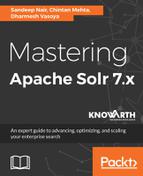Before we understand the new replication methods introduced in Solr 7, let's go through what was available for replication before Solr 7.
Until Solr 7, Solr had two options for replication purposes:
- Master-slave replication or index replication
- Solr Cloud
In master-slave replication, also known as index replication, the master shares a copy of indexed data with one or more slave servers. The master server's job is to index the data that is being added into Solr and share it with the slave servers while all read operations are performed in the slaves.
SolrCloud is a clustered environment of Solr that provides high availability and failover capability so that the content indexed using Solr can be distributed equally among multiple servers for scaling. In SolrCloud, one of the servers act as the leader and the rest of the servers in the cluster work as replica shards. Until Solr 7, in case of any issue on the leader server, any of the replica servers could act as a leader and form the leader-replica cluster. So in that case, data had to be shared with each of the nodes in the cluster, as leader shards and replica shards must remain in sync at any time. Each replica node performed the same operations as the leader. This replication, method available in SolrCloud before Solr 7, was known as NRT replicas.
In Solr 7, two new replication methods have been introduced:
- TLOG replicas
- PULL replicas
